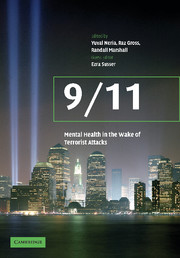Book contents
- Frontmatter
- Contents
- Acknowledgments
- Editors brief bio
- List of contributors
- Foreword
- Part I Introduction
- Part II The psychological aftermath of 9/11
- Part III Reducing the burden: community response and community recovery
- 9 Community and ecological approaches to understanding and alleviating postdisaster distress
- 10 What is collective recovery?
- 11 Rebuilding communities post-disaster in New York
- 12 Journalism and the public during catastrophes
- 13 Effective leadership in extreme crisis
- 14 Guiding community intervention following terrorist attack
- Part IV Outreach and intervention in the wake of terrorist attacks
- Part IV A New York area
- Part IV B Washington, DC
- Part IV C Prolonged-exposure treatment as a core resource for clinicians in the community: dissemination of trauma knowledge post-disaster
- Part V Disasters and mental health: perspectives on response and preparedness
- Index
14 - Guiding community intervention following terrorist attack
from Part III - Reducing the burden: community response and community recovery
Published online by Cambridge University Press: 27 October 2009
- Frontmatter
- Contents
- Acknowledgments
- Editors brief bio
- List of contributors
- Foreword
- Part I Introduction
- Part II The psychological aftermath of 9/11
- Part III Reducing the burden: community response and community recovery
- 9 Community and ecological approaches to understanding and alleviating postdisaster distress
- 10 What is collective recovery?
- 11 Rebuilding communities post-disaster in New York
- 12 Journalism and the public during catastrophes
- 13 Effective leadership in extreme crisis
- 14 Guiding community intervention following terrorist attack
- Part IV Outreach and intervention in the wake of terrorist attacks
- Part IV A New York area
- Part IV B Washington, DC
- Part IV C Prolonged-exposure treatment as a core resource for clinicians in the community: dissemination of trauma knowledge post-disaster
- Part V Disasters and mental health: perspectives on response and preparedness
- Index
Summary
Clearly many nations have faced terrorism's modern form for decades. Israel has faced terrorist attack against civilian targets since before its inception as a state. India is attacked daily by Muslim separatists from Cashmere, Spain has faced Euskadi ta Askatasuna (ETA) for decades, and Russia and China have faced terrorist attack from separatist movements that have brought violence and death to their major cities.
What is different about September 11th is that terrorists attacked the most powerful nation on earth using its own technology of aircraft and structural physics in a way that in minutes ended the lives of thousands in New York and nearly 200 lives at the Pentagon. The attack was the first on American soil since the all but forgotten attack by Japan on the Aleutian Islands during World War II, and even that attack and Pearl Harbor were not on the continental USA. Moreover, and easily forgotten, because no one knew what might occur in the wake of the aircraft genocidal attacks, the secondary threat was the belief that “anything was possible” in the hours, days, and weeks following the attack. Television news talked of possible, or even probable, secondary attack that could take the form of more airplanes, suicide bombers, chemical or biological weapons, or even an atomic attack. The US security establishment was clearly caught unprepared. Fully 5 hours after the attack (1:44 p.m. EST), the first warship and aircraft carriers were ordered dispatched from the US Naval Station in Norfolk, Virginia (US Department of State, 2002).
- Type
- Chapter
- Information
- 9/11: Mental Health in the Wake of Terrorist Attacks , pp. 215 - 228Publisher: Cambridge University PressPrint publication year: 2006
- 4
- Cited by

